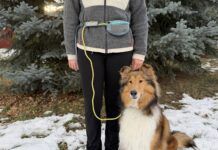When Amy and Aaron Gelfand hear their phone ring or a text alert ping, they know their response might save a dog’s life.
The Austin, Texas, couple are foster superheroes—they’ve given a temporary home to more than 552 dogs in need. Their animal rescue journey started 12 years ago when Amy saw a desperate social media plea from a nearby shelter begging for fosters.
“The shelter was overflowing with dogs,” Aaron says. “They were going to have to start euthanizing for space purposes. We love our dogs so much that Amy said, ‘We need to save a life.'”

Amy drove to the shelter and returned with Molly, a kind-eyed, floppy-eared, quite adorable Shepherd mix. “Molly was already in the euthanasia room when Amy got her out,” Aaron says.
Fostering is one way to help during the current animal shelter crisis. By taking a dog out of a shelter and fostering, you may even save another dog’s life by freeing up kennel space in a facility.
Since Molly, the Gelfands have fostered senior and adult dogs and specialize in helping pregnant dogs and caring for puppies.
“If we didn’t foster, another 40 to 70 dogs and puppies would die every year because that is what comes through our house on average,” Aaron says. “Texas shelters are always in crisis.”
Nationwide Animal Shelter Crisis
Typically, Texas shelters are always jam-packed, but right now, the Lone Star State facilities aren’t the only ones in crisis. A perfect storm has hit the animal rescue world, and many shelters nationwide are bursting at the seams.
“We’re way over the normal capacity we’ve seen in the past,” says Nina Thompson, director of public relations at the San Diego Humane Society. “We have a large amount of dogs coming in who are stray and not being picked up by their owners.”
Best Friends Animal Society says that more than 207,000 adoptable shelter dogs were euthanized last year. Some shelters have lines of people stretching down the block to surrender their dogs; other facilities are so full they’re turning away animals.
Experts all have theories about why: the rising cost of food, supplies, and veterinary care, the housing crisis, a lack of pet-friendly rental homes, and families who adopted pandemic pups and now don’t have time for a dog.
On top of all of this, adoption rates plummeted.
“When adoptions are slow, shelters fill up,” says Brent Toellner, senior director of lifesaving programs at Best Friends Animal Society.
According to Best Friends, in 2023, nearly 2.5 million dogs in the U.S. ended up in animal shelters, the highest number in the last few years.

“Some shelter staffs are struggling because they’re having to unnecessarily kill dogs and cats on a regular basis due to lack of space,” Toellner says. “Nobody gets into animal welfare because they want to kill healthy animals, yet that’s where a lot of shelters are right now.”
How to Help with the Animal Shelter Crisis
You can also be a lifesaving superhero by simply volunteering for an animal welfare organization. You can work in person or remotely from your laptop. “Different people have different skills,” Aaron says. “The thing to remember is shelters and rescues need help.”
Here are just some of the ways you can get involved:
Driving Dogs
The Gelfands are also volunteer rescue transporters. They pick dogs up from shelters and drive them to animal hospitals or other foster homes.
Flying Dogs
Many private pilots fly dogs from a shelter in one area to another region or even across the country, where a rescue group, adopter, or foster parent is waiting to give the pups a second chance.
Volunteering for a Shelter
There are many potential roles at most animal shelters, like walking dogs, cleaning kennels, taking cute pictures of dogs, writing their adoption bios, or greeting visitors. “Having someone to tell adopters what the process is or help introduce dogs to people are great volunteer opportunities,” Toellner says.
Volunteering for a Rescue
Contact local rescue groups and ask what help they need. Adoption coordinators are one example of a popular rescue (and shelter) role. These matchmakers work with adopters to pair them with a dog they hopefully fall in love with.
Spending Quality Time on Social Media
If you’re a social media whiz, use your skills to save lives. Shelters and rescues need volunteers to make cute videos and posts of dogs. “Even sharing an adoption profile on your social media pages might reach a different audience and end with an adoption,” Thompson says.
Fundraising
There likely isn’t a shelter or rescue that couldn’t use more donations. Food, supplies, and money are the keys to keeping the doors open. Organizations need savvy volunteers to help them apply for grants or hold in-person and online fundraisers.
Donating
Have some extra cash you’d like to give to a good cause? Find a shelter or rescue group whose work impresses you or a dog with medical needs that speaks to your heart and donate. Veterinary care is one of the most significant expenses organizations face. If you give to a nonprofit organization, donations are tax-deductible. (Depending on your tax situation.)
Starting a Pet Food Bank
Work with your community to organize and encourage people to donate pet food and supplies to dog and cat parents struggling to feed and care for their animals. This might also help keep pets from being surrendered to shelters. Check to see if an existing pet food bank in your area could use assistance.
Starting a Rescue
Now, this isn’t for the faint of heart. Animal rescuers say if they had to explain “how to start a dog rescue,” they’d warn you that running one is rewarding yet heartbreaking, even exhausting. It’s time-consuming—think emergencies, midnight phone calls, and struggling to pay the bills. Try volunteering with a group, learn the ropes, and then decide if starting a rescue is for you. (Which typically also involves applying to be a nonprofit.)
Spaying and Neutering Your Dogs
It can’t be said enough: Spay and neuter your dogs. One brief encounter between an unneutered male dog out looking for love with an unspayed female dog can result in a dozen unexpected puppies. “We have people coming to our doors with unwanted litters who are overwhelmed and can’t care for them,” Thompson says.
Adopting a Dog
Adoption is key to achieving the goal of no more homeless pets.
“Make adopting your first option,” Toellner says. “Every day you wait just increases the number of animals at risk.”
And you might be surprised by what you can find at local shelters.
“All the dogs that you may associate with having to go to a breeder are now at our shelter,” Thompson says. “We have a Doodle. We have a French Bulldog. We have a Golden Retriever. And if you think you can’t get a puppy at the shelter, we have 185.”
Fostering a Dog
Oh yes, here we are back at fostering, one of the top ways you can help during this animal shelter crisis.
Let’s break this down a bit more: fostering can be an hour, a day, a weekend, a week-long, or a months-long gig. Many shelters and rescues pay for all the dog’s veterinary care and supplies.
“We can learn so much about a dog in a foster home that we can’t in the shelter because the shelter is so unnatural for them,” Thompson says. “When you foster, you expose that dog to a new network. You might walk that dog in your neighborhood, and somebody falls in love with that dog and adopts.”
Yet that adoption part—the thought of saying an emotional goodbye to a foster dog often keeps people from fostering—they worry they would become too attached to a dog and heartbroken when they left.
Many rescues allow you to adopt your foster dog. But the Gelfands say if someone else adopts your foster, it doesn’t mean having to say farewell forever.
The couple created a private social media page to stay in touch with adopters of their foster dogs. Their new families share pictures, videos, and heartwarming stories of how much the dogs mean to them—and they’re so thankful the Gelfands played such a vital role in saving their dogs’ lives.
“You can love them and still be happy when they find their forever homes,” Aaron says. “One of our mama dogs got adopted by our next-door neighbor who lost her husband to cancer, and that dog has been her lifeline. We get to create these happily ever afters for people.”












